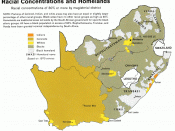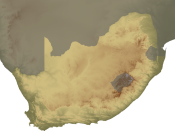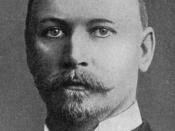The creation of the Union of South Africa was the result of numerous events throughout South Africa, spanning from the late 19th Century through to the Early 20th Century. Racial discrimination was a burden that had been and is still somewhat today, unfortunately, a large part of South African life. Furthermore, there were compromises through these issues that played a key role in the creation of the union.
Numerous items of legislation stamped the establishment of the Union of South Africa as a state in which racial discrimination received official sanction. The Native Labour Regulation Act (No. 15) of 1911, stood clearly discriminative as it made it a criminal offense for only Africans, however not for whites, to break a labor contract. The Dutch Reformed Church Act of 1911 provented Africans from becoming full members of the church. The Mines and Works Act (No. 12) of 1911 approved the long-term mining practice by which whites dominated skilled jobs by effectively restricting Africans to the lower classed or unskilled jobs in the mines.
Most important of these was the Natives Land Act (No. 27) of 1913 which separated South Africa into areas in which either blacks or whites could own freehold land: Blacks, making up two-thirds of the population, were restricted to just 7.5 percent of the land, when they were in fact the majority, where as the whites, making up just one-fifth of the population, were given 92.5 percent of the land mass. The act also stated that the only way that Blacks could go outside their borders was in the case of them being hired by a white land owner as laborers. The Acts also made it illegal for the common practice of having Africans work as sharecroppers on farms in the Transvaal and the Orange Free State.
As the Liberal Government realised that in reality it was quite unlikely that white English Speakers would become a majority in South Africa, the Government came to a decision to seek terms with the Afrikaner Majority. The British granted limited self-government in 1907 to both the Transvaal and the Orange River Colony, and in subsequent elections, Het Volk and the Oranje Unie swept to victory. In the following year, the South African Party (SAP), led by an English-speaking critic of British imperialism and dependent on the support of the Afrikaner Bond, came to power in the Cape Colony. Reassured by the readiness of Het Volk's leaders, Botha and Smuts, to assist the gold-mining industry in obtaining larger supplies of cheap black labor (although without the Chinese workers who were repatriated in 1908) and in repressing militant white miners (who protested conditions of labor and job competition from blacks), the British government encouraged negotiations in South Africa among white representatives of the four self-governing colonies with the aim of establishing a single state.
A consitution was produced following negotiations in 1908 and 1909 which upheld these 3 fundamental laws: South Africa would become a unitary state, hence following a westminster style government, where by a simple majority, political power would be won and become supreme. It was up to each of the four self-governing colonies as to what their stance on black voting rights would be(the Cape and Natal based their franchise on a property qualification; the Orange River Colony and the Transvaal denied all blacks the vote) English and Dutch were also assigned as official languages. The future incorporation of the British-governed territories of Southern Rhodesia, Bechuanaland (present-day Botswana), Basutoland (present-day Lesotho), and Swaziland was also promoted by the constitution into the union.
Louis Botha became the first prime minister of the newly established Union of South Africa in a dominion of the British Empire in May of 1910. Jan Smuts became his deputy, both men had been generals in Kruger's army just eight years earlier; now, they governed a country of 4 million Africans, 500,000 coloureds, 150,000 Indians, and 1,275,000 whites through the SAP.
Resistance from blacks was endangered by Milner's pro-white policies which was then followed by the discriminatory legislation brought upon by the Union of South Africa, this led to the formation and growth of new political bodies. The African Political Organisation was formed in 1902 by coloureds to represent the interests of "Educated, Coloured people." A Scottish-trained doctor, Abdullah Abdahraman, became president of the organization in 1904 had built it into a vital body with 20,000 members by 1910 by stressing the political discrimination to which coloureds were being the victim of. A passive resistance campaign against the pass laws in 1906 was began by Mohandas Gandhi, leading Indians in Natal and the Transvaal (they were legally prohibited from living in or entering the Orange Free State) Into organizing stop-work protests and demonstrations which for thousands of people won support. The Africans, held numerous meetings for coloureds and Indians to protest the white-only nature that took place in 1908 to 1909 during the constitutional discussions. In March 1909, At a South African Native Convention, these activities culminated in which called for a constitution giving "full and equal rights" for all blacks, coloureds, and Indians.
Afrikaners did not really want to negotiate and were quite sceptical about the compromises with whites.A Prime example of this can be found when, Afrikaner leaders were not prepared to work with Jameson, which in turn resulted in Jameson losing government support in the Cape parliament. John Merriman, with the support of his South Africa Party and the Afrikaner Bond, was able to form government in February of 1908. A dialogue with Merriman was promptly commenced by Smuts to form a union of the four 4 colonies.
The Cape and the Transvaal came to an understanding on several issues. At an inter-colonial conference in May 1908, Smuts moved six resultions proposing procedures to be adopted. The incompatibility of the railway and customs interests of the colonies and the destructive effect they had was pointed out at the Selbourne memorandum. The delegates could not agree at these conferences as each was out to prtect and look after their own colony's interests.
The High Commissioner was called upon to arbitrate the disputes. Only closer union could avoid the danger of open conflict and allow white South Africans to produce effective control over matters vital to their welfare and prosperity. With both large African and Indian populations, there was also a need to address their treatment and relations.
Evidently, the case in South Africa was that the racial issues were still very prominent and as had been commonly seen throughout its history it was a case of the whites attempting to overpower what is seen as a minority group..Not in numbers but in sources of power, most definitely the whites had the upper hand and through this Union the compromises between the two was seen, through the creations of the new constitutions and the sanctions that were taken out.


